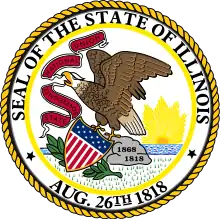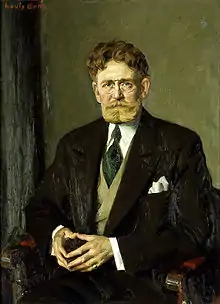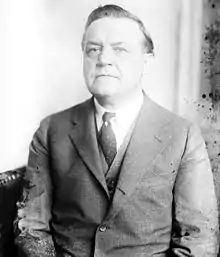1913 United States Senate elections in Illinois
Two United States Senate elections (a regular and a special election) were held in Illinois on March 26, 1913. The two elections were interconnected through a compromise made to elect a Democrat in the regular election and a Republican in the special election.
| ||
|
| ||
| Elections in Illinois |
|---|
 |
These were the last elections to U.S. Senate from Illinois to take place by vote of state legislature, as the Seventeenth Amendment to the United States Constitution would make all subsequent U.S. Senate elections conducted by a popular vote.
The elections saw the election of Democrat J. Hamilton Lewis to a full term in the state's class 2 United States Senate seat in a regular election, and Republican Lawrence Y. Sherman to the state's class 3 United States Senate seat in a special election.
Background and procedure
At the time, since the Seventeenth Amendment to the United States Constitution was yet to take effect, U.S. Senate seats were filled by votes of state legislatures.
In the November 1912 state elections, the Republicans lost control of the Illinois General Assembly due to the Republican / Progressive split. But while the Democrats held a plurality of the Illinois General Assembly, they did not have a majority. The General Assembly took up the matter of electing the senators on February 1. The General Assembly therefore failed to elect until after the new congress began.
On March 26, in a compromise arranged by governor Dunne, the General Assembly elected Democrat J. Hamilton Lewis to fill the full-term seat and Republican Lawrence Y. Sherman to fill the two remaining years of a vacancy that had just recently opened.
Party primaries
Non-binding preference primaries were held April 9, 1912, which informed the legislature of the preferred candidate of voters in each party's primaries. They coincided with binding primaries held for other offices.[1]
While the party was eligible to hold a primary, no Socialist primary was held for the office of U.S. Senator.[1]
Candidate
- James H. Lewis, former at-large U.S. congressman from Washington
Result
| Party | Candidate | Votes | % | |
|---|---|---|---|---|
| Democratic | James H. Lewis | 228,872 | 100 | |
| Total votes | 228,872 | 100 | ||
Candidates
- Shelby Moore Cullom, former governor of Illinois
- Lawrence Yates Sherman, former lieutenant governor of Illinois and former speaker of the Illinois House of Representatives
- Hugh S. Magill, Illinois state senator[2]
Result
| Party | Candidate | Votes | % | |
|---|---|---|---|---|
| Republican | Lawrence Y. Sherman | 178,063 | 46.16 | |
| Republican | Shelby Moore Cullom | 129,375 | 33.54 | |
| Republican | Hugh S. Magill | 78,344 | 20.31 | |
| Total votes | 385,782 | 100 | ||
Candidate
- Alonzo E. Wilson
Result
| Party | Candidate | Votes | % | |
|---|---|---|---|---|
| Prohibition | Alonzo E. Wilson | 3,786 | 100 | |
| Total votes | 3,786 | 100 | ||
Regular election (class 2 seat)
| |||||||||||||||||||||||||||||||||||||
| |||||||||||||||||||||||||||||||||||||
| |||||||||||||||||||||||||||||||||||||
On April 12, 1912, five-term Republican incumbent Shelby Moore Cullom lost renomination to Lieutenant Governor of Illinois Lawrence Y. Sherman in the Republican "advisory" primary, where the voters expressed their preference for senator but the decision was not binding on the General Assembly, which made the actual choice. Cullom had suffered politically over his support for the other Illinois senator, William Lorimer, who was embroiled in a scandal over alleged bribery in his 1909 election to the Senate.
After his defeat, Cullom withdrew his name from consideration by the General Assembly.
The Illinois General Assembly eventually elected the Democratic nominee, Congressman J. Hamilton Lewis March 26, 1913, who had also won the Democratic advisory primary, as the sole candidate on the ballot.
| Party | Candidate | Votes | % | |
|---|---|---|---|---|
| Democratic | J. Hamilton Lewis | 164 | 80.39% | |
| Progressive | Frank H. Funk | 22 | 10.78% | |
| Republican | Lawrence Y. Sherman | 9 | 4.41% | |
| Independent | Abstaining | 5 | 2.45% | |
| Socialist | Bernard Berlyn | 4 | 1.96% | |
| Democratic gain from Republican | ||||
Special election (class 3 seat)
| |||||||||||||||||||||||||||||||||||||
| |||||||||||||||||||||||||||||||||||||
| |||||||||||||||||||||||||||||||||||||
Three months after the primary in which Sherman defeated Cullom, the U.S. Senate invalidated William Lorimer's 1909 election and declared the seat vacant.[6] The Illinois Attorney General, William H. Stead determined that the General Assembly had failed to properly elect Lorimer in 1909 and so the Governor could not appoint a replacement.[7] As a result, the General Assembly had a second Senate seat to fill.
| Party | Candidate | Votes | % | |
|---|---|---|---|---|
| Republican | Lawrence Y. Sherman | 143 | 70.10% | |
| Democratic | Charles Boeschenstein | 25 | 12.26% | |
| Progressive | Frank H. Funk | 22 | 10.78% | |
| Independent | Abstaining | 9 | 4.41% | |
| Socialist | McDonald | 4 | 1.96% | |
| Democratic | John Fitzpatrick | 1 | 0.49% | |
| Republican gain from Vacant | ||||
References
- Illinois blue book, 1913-1914. Illinois Secretary of State. p. 460. Retrieved 19 December 2020.
- "Our Campaigns - Candidate - Hugh S. Magill". www.ourcampaigns.com. Retrieved 19 December 2020.
- Taylor, Julius F. "The Broad Ax". Illinois Digital Newspaper Collections. Retrieved June 22, 2015.
- "IL US Senate". Our Campaigns. Retrieved March 27, 2020.
- United States Senators Chosen, 1913, p. 458.
- "Lorimer ousted by decisive vote". The New York Times. July 14, 1912.
- "Lorimer never elected". The New York Times. July 18, 1912.
- "IL US Senate Special". Our Campaigns. Retrieved March 27, 2020.
Bibliography
- "United States Senators Chosen, 1912". The Tribune Almanac and Political Register 1913. New York: The Tribune Association. 1913. p. 457 – via Hathi Trust Digital Library.


.jpg.webp)